Evaluation
1. In what ways does your media product use, develop or challenge forms and conventions of real media products?
Opening sequences establish characterisation (an introduction to who the protagonist and antagonist may be), setting, genre, narrative, visual style and ideology.
Before even beginning the preliminary task, we were instructed to research opening sequences to popular films. We collectively researched the opening sequence to ‘Dirty Harry’ (Don Siegel 1997), ‘The Usual Suspects’ (Bryan Singer 1995) and ‘Mr & Mrs Smith’ (Doug Linman 2005) and I individually researched the opening sequence to ‘Over Her Dead Body’ (Jeff Lowell 2008). All three films despite being different genres, are conventional and traditional to their own genre. ‘Dirty Harry’ and ‘The Usual Suspects’, are both mystery/action movies. They both use quality editing techniques and camera angles which work effectively to establish characterisation (protagonist/antagonist), setting, genre and narrative, as well as visual style and even ideology. ‘Over Her Dead Body’ fits the romantic comedy genre well due to characterisation and setting. ‘Mr & Mrs Smith’ is slightly more unconventional as its opening sequence is very minimal and unclear. Despite this, it is a successful opening sequence as it draws the audience in.
In comparison to all of these media products, our opening sequence establishes characterisation fairly well. Jack is victimised by high angle shots at the start of the sequence, just like the woman in the pool in Dirty Harry. Also similarly to Dirty Harry, when Jack (the protagonist) is first seen on-screen, the music is slow, relaxed and relatively happy. In Dirty Harry there is an upbeat song playing as he is first seen in contrast to the eerie, distorted sounds when the antagonist is seen looking down the barrel of a gun. This emphasises that Jack will cause no harm, he is vulnerable; he is ‘the good guy’. Also by hanging the black work shirt in Jack’s sophisticated bedroom it makes him appear more adult like as he holds more responsibility.
Our opening sequence does not have an establishing shot unlike Over Her Dead Body and Dirty Harry. We consciously chose not to include one as we wanted to keep all footage inside the house, leaving the outside world a mystery, just as the missing daughter is a mystery. However we see that Jack wakes up to an alarm clock in a modern, simple bedroom and walks around his house so the setting is made clear; it’s a normal home where events such as missing daughters are highly unlikely. All of the footage in the opening sequence of Mr & Mrs Smith is internal, in only one room in fact yet the setting is made quite clear; this was our inspiration.
In Dirty Harry, there are distorted noises and dramatic music which build tension. This influenced us to include ‘scary’ music in our title sequence; the generic gloomy keyboard melody helps build tension also but in a much more thrilling sense, especially as the volume gets louder as the music becomes more intense. The use of this song alongside the unnatural visual effects such as the flashes and the echoes makes it easily determinable to the viewer that “12 Hours” is a thriller. Our actual opening sequence doesn’t display signs of it being a thriller but this was a conscious decision to trick the audience into thinking that the film they’re about to watch would be mild and tame, before being taken for a thill ride throughout the rest of the film.
The narrative in our opening sequence is made quite clear, unlike our first attempt. I feel that re-filming the whole sequence has benefited us and the viewer greatly! It is obvious that each individual clip follows on in chronological order which makes it easier for the audience to interpret; however they wont appreciate this as chronology is a given in everyday life. The note on the fridge “I HAVE YOUR DAUGHTER” is where the narrative is first picked up. The viewer knows that the problem has arisen and they follow Jack as he is made aware of the truth behind the message. Jack phones the police and waits… The viewer wants to know what happens next. This is a key sign of successfully establishing narrative. No film is successful without establishing a clear narrative at the start of the film as it is just not gripping enough to encourage the viewer to continue watching.
The visual style established in Over Her Dead Body is interesting. It’s all bright colours; the green grass and the blue sky. This fits in well with the feminine streak to the film. However in The Usual Suspect all the colours are dark and it’s quite difficult to make some things out. In our opening sequence we decided to play with shadows, especially when Jack walks out of his room and he becomes a silhouette. The use of the dark against the light emphasises that not all in the world is good, there’s still darkness and uncertainty. It kind of foreshadows future devastation just through the use of visual style alone. We also used a black and white title sequence and this theme would make a constant reappearance throughout the duration of the film.
In terms of ideology; common sense, one’s hopes and expectations play a part in establishing who’s side the audience place themselves on. The audience are aware in our opening sequence that there is an antagonist who has taken Jack’s daughter however unlike in Dirty Harry, our antagonist is not seen in the opening sequence. Viewers of our sequence would be on Jack’s side due to the fact that the antagonist remains anonymous and that they are able to empathise with Jack through his point of view shots and the saddening slow motion towards the end of the opening sequence.
As mentioned, our title sequence was made distinct by using monotones, layering the footage to create echoes and flashing ‘cartoon’ versions of the footage over the original footage. This already looks disturbing however the creepy music contributes to this also, just as both the imagery and audio create this effect in Kyle Cooper’s opening sequence to ‘Se7en’. The black and white theme from the title sequence is carried through to the opening sequence.
To an extent we did not challenge or develop the conventions of thriller opening sequences, the music and colours we used are fairly traditional, and establishing the genre is conventional, which is something we have done. However unconventionally we have kept all footage internal to the building. Mr & Mrs Smith is extremely unconventional by literally only using one camera angle; ours is not as extreme as this, but it is still slightly pushing boundaries.
As we have stuck by the rules of real media conventions, our opening sequence is successful at establishing characterisation, setting, genre, narrative, visual style and ideology.
2. How does your media product represent particular social groups?
As our opening sequence is internal to one building and one character, we haven’t emphasised representation of particular social groups however we have included giveaway clues. Obviously Jack is speaking English in an British accent which shows he is British. This can then be pinpointed to a fairly southern English accent as he speaks in a relatively posh tone. This identifies his regional identity and gives us an idea of his social class; it makes him seem like a ‘normal’ man.
- Jack is a dominant male
- high angle shots, and effective narrative look down on him which weakens his status
- we have chosen to represent the male social group in this way to prove that even the strongest people can experience trauma
As Jack in real life is only 17, it was difficult to make him seem older. In order to help this though we hung the black shirt in his room which makes him appear responsible, and with age comes responsibility. We also chose that Jack would wear pyjama’s which would hopefully make him seem older, which we feel has worked better than our first opening sequence when he was wearing just boxers. Another key point is that Jack has a daughter. Again this gives him responsibility AND age. So we have tried to include the social group of middle aged men. We included this because this is the image which we wanted Jack’s character to portray; the ‘everyman’ character is much easier to empathise with as everybody can relate to this person.
3. What kind of media institution might distribute your media product and why?
- Films can be released by:
- TV broadcast
- theatrical release which is when a film is released in cinemas
- home entertainment, which is blue-ray or DVD
- The company responsible for the release of the film is the film distributer.
A few major film distributors are Universal Pictures, 20th Century Fox and Film4. We have chosen Film4 as our film distributors, because they are the distributors of many major films, for example ‘127 hours’ and ‘Slumdog Millionaire’. Another reason in which we chose Film4 is that they distribute a lot of low budget films, which ours definitely is, so it fits the criteria.
One factor that made Film4 very appealing to us was their excellent reputation, for distributing high quality, award winning films. This means that, even without watching the film, people would assume that it will be well made and has a good storyline, so we would immediately have and audience broader than our initial target audience. Their dedicated fan base would benefit us hugely.
Film4 usually use ’Standard Release’. This is where the film is first released only in cinemas, and roughly 16 weeks later, it is released on DVD. Several months later, it is then broadcast on television, through Film4’s own channel. This method would be very beneficial, because it gives people numerous chances to see the film, and every time it is released, whether it is to cinema, DVD, or television, it is advertised. This means it will be almost impossible for people to not hear about the film. The broadcast on television allows people with less money to be able to see the film too, because they don’t have to pay for a cinema ticket, or to purchase the DVD.
4. Who would be the audience for your media product?
This is a photo of my cousin Ashley (23) and his girlfriend Louise (22). They like to go to the cinema at least twice a month or maybe more if there are good films out at the time. They like to have a good time and both recently went sky diving together; they are thrill seekers. They are an indication of our target audience; young thrill seekers who like to have a good time!
- aimed ever so slightly more at males as they stereotypically enjoy adrenaline more than girls
- not excluding females from our audience completely, as females are more sensitive and will be able to sympathise Jack’s trauma more easily and openly.
The age range for our target audience is from late teens to early thirties, roughly 18 – 32 year olds. Any younger or older than these ages and the viewer may be more sensitive to and upset by the violence in the film. Also, we have rated our film an 18. This is because we want to reach the full potential for a thriller and to do so means including gore, violence and things which don’t even bare thinking about. Also by having an 18 rating rather than a 15 it screams out to thrill seekers that it is extremely scary, much scarier than something a 15/16/17 year old could handle. They know they’ll get more of a buzz from it which means the product will sell well.
We used the narrative of a missing daughter because most people have children during the age range of our target audience which means they can become more involved in the film rather than simply just watching it as they know how heartbreaking it would be to lose a child.
5. How did you attract/address your audience?
To address our audience, we originally showed the film to media students, and asked them for feedback. In doing this, we were able to dramatically change the sequence, to the point where we actually re-filmed the whole thing and edited the storyline. I am very happy about the decision to do this, because asking people from our target audience for feedback and advice on our film meant that we made it more appropriate and desirable to them. We asked people to write down their opinions on the sequence. This enabled us to really direct the film to our target audience.
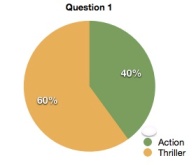 After editing our first version of the video we asked people what genre they thought the film was. 60% of people thought our film was a thriller, which is the genre we decided to create. 40% of people thought the film was an action film. Although more than half of the people asked thought the film was a thriller, we still wanted to make it even more obvious that our film was a thriller. So after re-filming and re-editing our video, we decided to ask for further audience feedback to assess whether re-filming was worthwhile.
After editing our first version of the video we asked people what genre they thought the film was. 60% of people thought our film was a thriller, which is the genre we decided to create. 40% of people thought the film was an action film. Although more than half of the people asked thought the film was a thriller, we still wanted to make it even more obvious that our film was a thriller. So after re-filming and re-editing our video, we decided to ask for further audience feedback to assess whether re-filming was worthwhile.
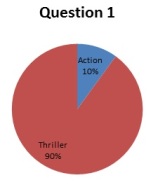 After filming our second version of the video, we asked the same question; what genre people thought our video was. This time, 90% of people thought that it was a thriller, which is a much stronger result than previously and we were much happier with this result, which means that re-filming our video was definitely a good choice.
After filming our second version of the video, we asked the same question; what genre people thought our video was. This time, 90% of people thought that it was a thriller, which is a much stronger result than previously and we were much happier with this result, which means that re-filming our video was definitely a good choice.
When we refilmed and edited, we posted the film on YouTube and Facebook. Posting it on YouTube, in particular, meant that a very diverse range of people might see the film, and so we would know which types of people are more interested in it, allowing us to know who our main audience are.
Another way in which we addressed our audience was through researching genre. In doing this, we were able to find out more about action thrillers, and include some of the typical conventions of them. This assured us that it would appeal to our target audience, because it will be in the same style as the types of films that they enjoy. The things we included in our film to mirror features found in other thriller films were silhouetted characters, creepy, distorted flashing images and black and white frames.
As our film was aimed at a younger audience rather than an older audience we wanted our characters to represent this age group, so that the target audience could connect more with the characters. In order to do this we used Jack as our main character, a young male of a similar age to our target audience. We dressed him in suitable clothing; tracksuit bottoms and a plain grey t shirt as we believe this is the kind of thing people of a similar age would wear to sleep in.
6. What have you learnt about technologies from the process of constructing the product?
Whilst researching opening sequence many options opened up. Initially I had been dependant on the internet for all research I ever conduct. However it became aware to me that the best research was by breaking down and analysing real media products, such as the opening sequence to Dirty Harry which we tore apart!
During planning our opening sequence I learned how use a scanner. I drew our story board and then scanned it into the computer, and then used photoshop to ‘cut’ the paper into the individual squares.
Whilst filming, the technologies available to us was the camera which was lent to us by school and Megan’s camera on her phone to film the title sequence. We all got the chance to play around with the camera and we discovered that it had a ‘night mode’ which we used in our first attempt of the opening sequence but as the quality was so poor it was not of an advantage to us anyway.
We used Final Cut Pro and Sony Vegas throughout the editing stages and we were able to pick up the skills required to use the software successfully pretty quickly.
By using new technologies such as these mentioned I feel slightly more creatively confident and feel as though, as tiny as it may be, I have gained some experience which I hope to take forwards with me in whatever I plan to do in life.
7. Looking back to your preliminary task, what do you feel that you have learnt in the progression from it to the full product.
In the progression from filming my preliminary task, to producing my opening sequence, I feel that I have learnt a lot about filming and editing.
In the preliminary talk, we used a cheap flip camera, and this made our short clip look very poor quality. I am happy that we did the task, because it meant that we could make a conscious decision to use a more expensive, better quality camera when filming our real piece.
Another weakness of our preliminary task was that we didn’t use a tripod. When we watched it back, this was very obvious, as it was shaky. From doing this, we realised that we would definitely need to use a tripod for or sequence, to keep a steady shot, making it look much more professional. However, we also chose to use handheld camera at one point in the film, because we wanted it to be a point of view shot. We made this decision as we thought that the jerkiness of the shot would emphasise the panic.
In the preliminary task, we had problems with lighting, as we filmed part of it into the light. We found that this was ineffective, because it meant the character that was meant to be the focus of the shot, was hard to make out, and was almost a silhouette. When we filmed our real sequence, we remembered the difficulties we had when doing the preliminary, so we were able to avoid it. However, we did actually film into the light a couple of time, but we made a conscious decision to do this, as we wanted the character to be more of a silhouette at that point, but doing the preliminary task showed us that this was possible.
I also progressed a lot in terms of my knowledge on editing. For the preliminary task, our editing skills were to a minimum, and we only did very basic transitions. We cropped down the clips to the appropriate length, and fitted them together, but we were not very good at making them run smoothly, and e struggled to use interesting effects. Before editing our opening sequence however, i experimented with Sony Vegas: better quality editing software than we has used previously, and got to know it well so that I could use interesting effects such as fading, colour grading and altering sound. I think this was possibly where I improved my skills the most out of all the areas involved in film production.
Our preliminary only lasted 35 seconds, so we didn’t really have to think about scene changes, or a change in atmosphere, as it was such a small space of time. However, in or opening sequence, which lasts a few minutes, more happens and we needed to capture the atmosphere change from when he is docile and calm when he wakes up, to when he sees the note and becomes panicked and frustrated. We thought about ways in which we could reinforce this change, and decided that the use of camera, editing and sound would all be very important. We used editing to show the change, by making the cuts longer at the start so it seems slow pace. We used non-diegetic sound, by editing in music to sound as though the radio is playing, and we chose some very calm music to help set the atmosphere. At the start, we used the camera on a tripod in most of the shots, so that it was a steady frame, but when he is panicked, we included a hand held shot, so that we are seeing it through his eyes, and we feel the panic more.
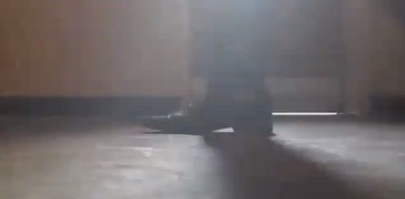 In our preliminary task, our use of light was poor as we learnt that filming into the light created a glare and made the screen too light to look at meaning the image was not clear.
In our preliminary task, our use of light was poor as we learnt that filming into the light created a glare and made the screen too light to look at meaning the image was not clear.
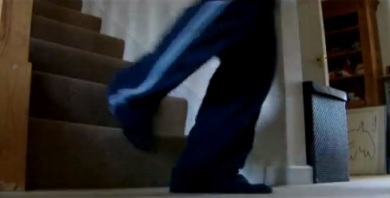 This meant that in our final video we were aware of the issue with the lighting and we could eliminate this problem, creating a clear image which could be seen properly, enhancing the experience for the viewer.
This meant that in our final video we were aware of the issue with the lighting and we could eliminate this problem, creating a clear image which could be seen properly, enhancing the experience for the viewer.

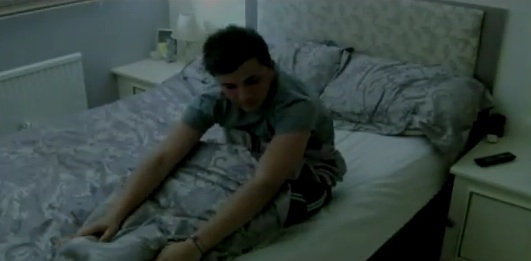
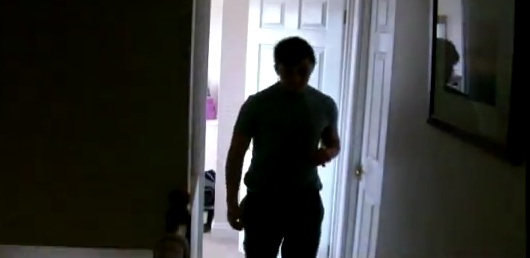
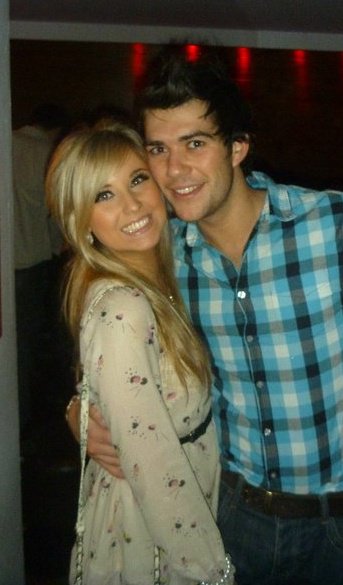
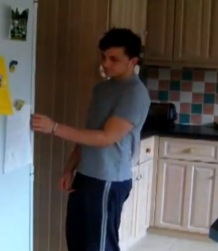
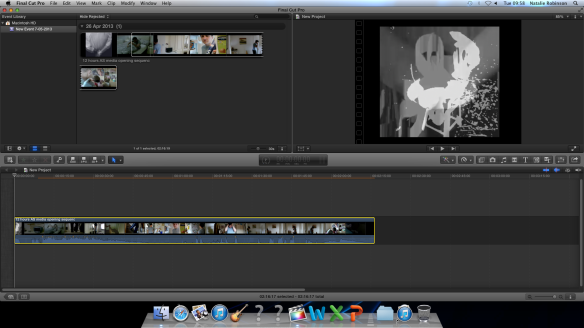
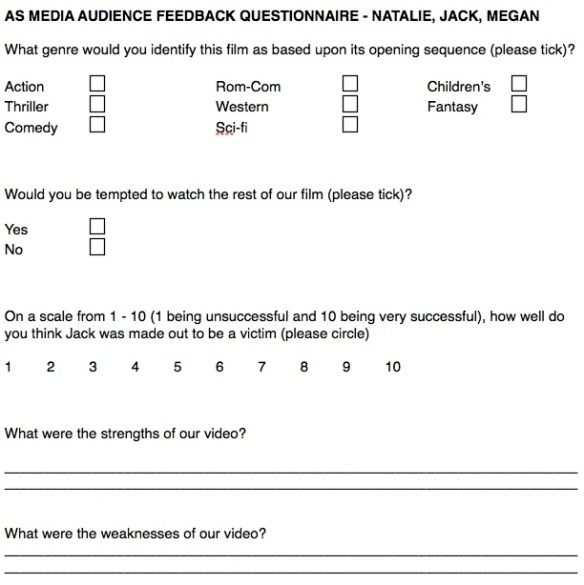
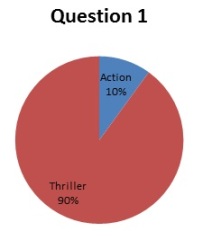
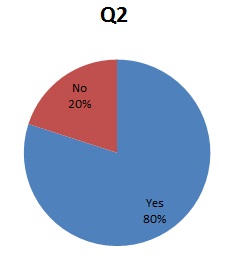
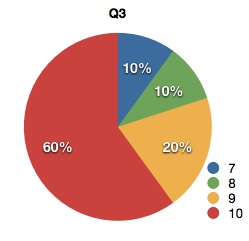
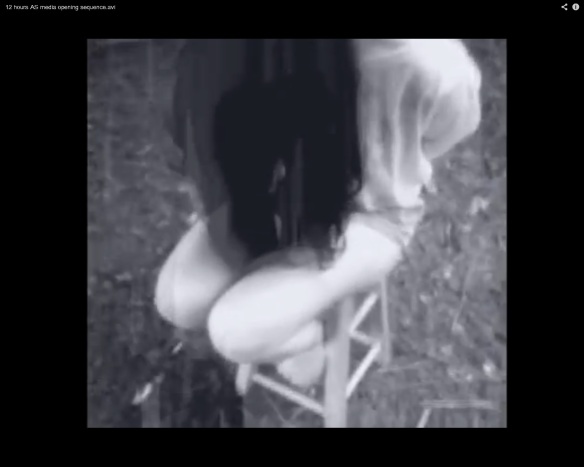
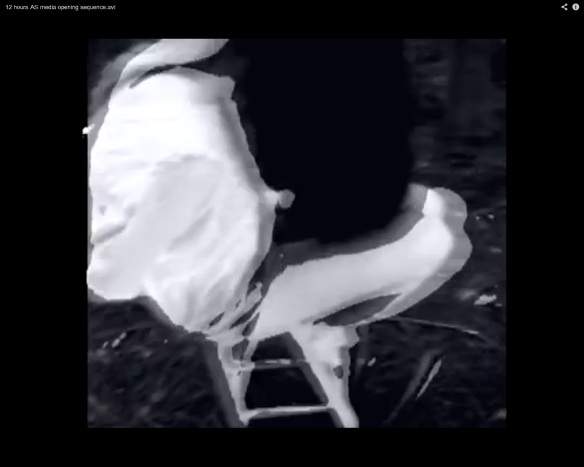
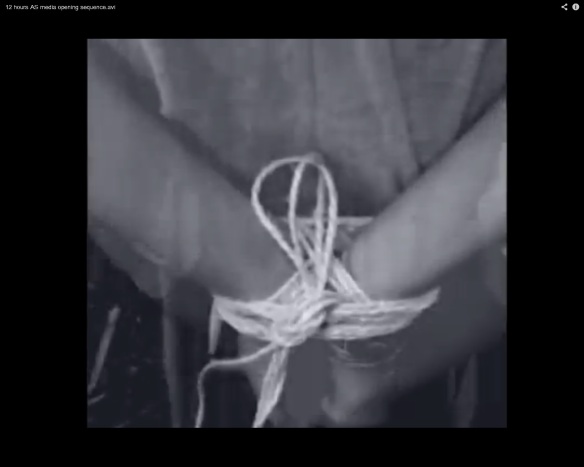
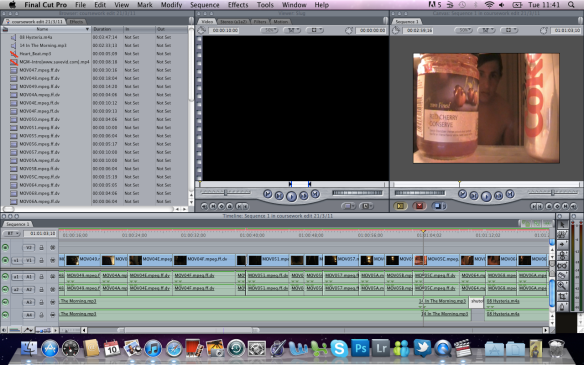
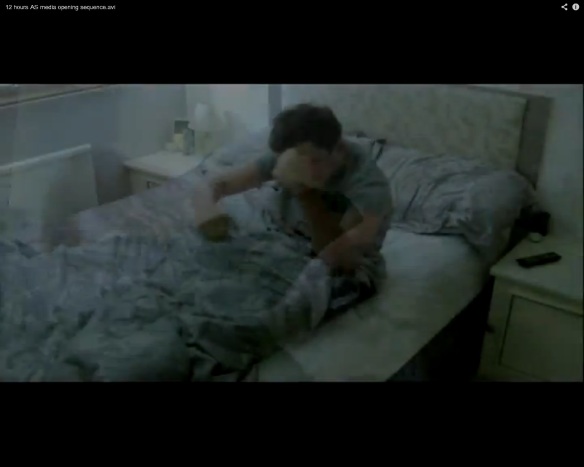
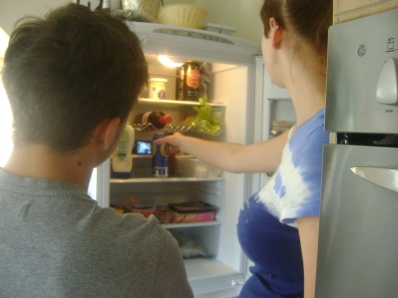 Next comes my favourite shot of the sequence. Jack goes to the fridge and as the door opens the camera switches to an internal shot from the fridge; a mid shot looking out at Jack rummaging around looking for breakfast. We agreed to use this shot even before we knew what our storyline would be because it is just so visually creative, it’s original.
Next comes my favourite shot of the sequence. Jack goes to the fridge and as the door opens the camera switches to an internal shot from the fridge; a mid shot looking out at Jack rummaging around looking for breakfast. We agreed to use this shot even before we knew what our storyline would be because it is just so visually creative, it’s original. He will also wear a plain grey t shirt, again to make him appear older and more father like, by keeping it simple.
He will also wear a plain grey t shirt, again to make him appear older and more father like, by keeping it simple.